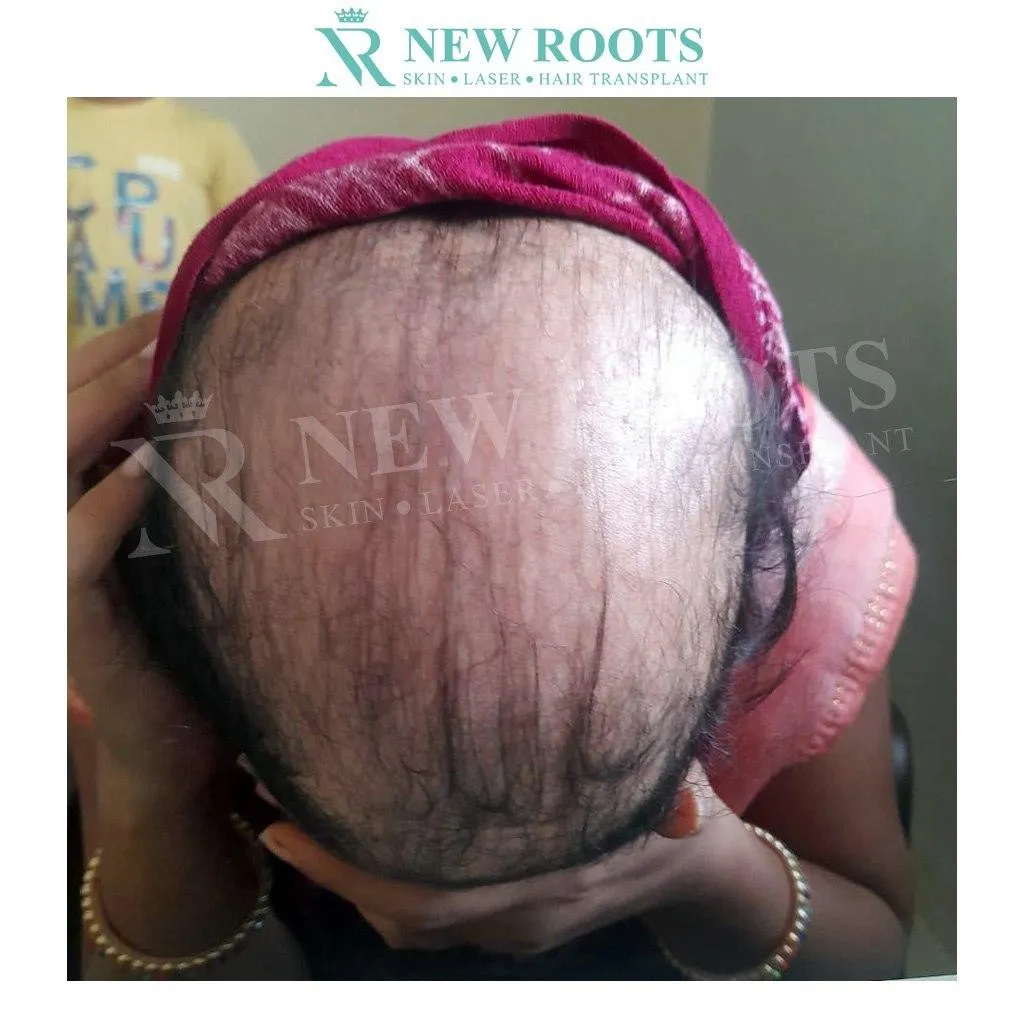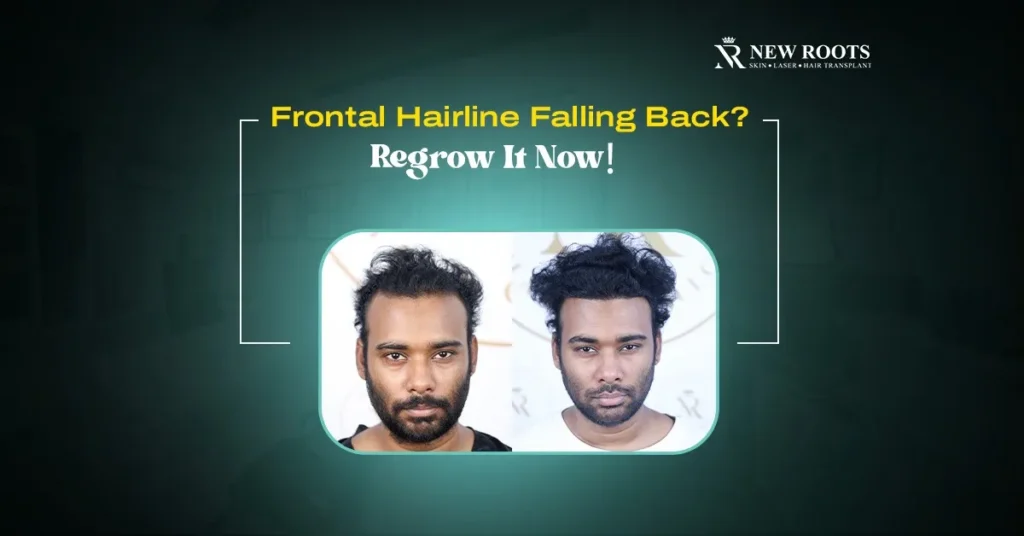One of the many hair problems that are being faced by many people in India today is that of a receding hairline.
This desire to know how to regrow frontal hairline has also resulted in further research on the many procedures, therapeutic approaches, and alterations to lifestyle necessary to maintain or achieve the best result for such struggles.
Some of the key causes of hair loss and reformation of the hairline include genetic ailments, hormonal imbalances, and certain medical conditions that necessitate a multifaceted approach to deal with the problem.
Introduction
Now, presumably, a huge number of people suffer from baldness, for which it is worth knowing how to regrow frontal hairline.
From heredity to diet and other lifestyles, hair loss actually does a number on self-esteem, which we unfortunately all know too well.
With the help of specialized measures and practicing an integrated approach, it is possible to solve such problems as the hairline recession and improve, in general, the hair’s condition.
Table of Contents
Understanding Causes Of Hair Loss
Losing hair is due to causes that interfere with the normal growth of hair. Knowledge of such factors is central to treatment management and the selection of the right strategy. Common causes include:
Genetic Thinning: An inherited disease that causes androgenetic alopecia.
Hormonal changes: If the hair growth cycle is interrupted, hormones can trigger hair loss, for instance, amongst women for the duration of their menopause or being pregnant.
Inflammatory Alopecia: A few skin diseases, along with alopecia areata, can cause patchy hair loss.
It is terrible to know that most people are drained psychologically because of hair issues; that’s why it is vital to know how to attain frontal hairline growth.
Types of Hair Loss
There are numerous diagnosed styles of hair loss, each related to distinctive mechanisms and factors:

Alopecia Areata
This is one of the autoimmune diseases whereby the body’s immune system objectives hair follicles, causing hair loss in areas of the scalp.
Alopecia areata can expand anywhere there may be hair and can be severely patchy (alopecia areata) or total head hair loss (alopecia totalis) via full body hair loss (alopecia universalis).

Traction Alopecia:
This form of hair loss occurs from tight cornrows, ponytails, beard cornrows, or the frequently used extensions.
But, the regular strain of sportswear out hair follicles and causes hair loss, in particular in the areas across the hairline.

Androgenetic Alopecia:
The general public talks about this as male-pattern baldness, or’ girl-pattern baldness,’ even though the situation is hereditary and arises in both sexes.
A commonplace pattern includes a sluggish retreating hairline or baldness crown in men, while in women it's far a thinning of hair all over the scalp, although no longer complete.
This situation is specifically related to hormonal changes and aging.

Telogen Effluvium:
Telogen effluvium can be related to transient baldness and happens while several hair follicles switch to a resting phase of hair growth.
This will be a result of stress, hormonal modifications, infection, or the use of positive styles of medicinal drugs.
The condition causes extra diffuse and giant hair loss as opposed to the usual bald patches, and hair will be returned as soon as the cause is recognized.

Cicatricial Alopecia:
This is an alternatively unusual, and once in a while, terminal form of hair loss that happens as irritation reaches the hair follicles, destroying them and replacing them with scar tissue.
The condition can be related to other inflammatory pores and skin problems, and if so, it could cause baldness in regions of the pores and skin affected by the condition.
Significance of Spotting Kinds of Hair Loss
Figuring out the particular form of hair loss an individual is experiencing is vital for several reasons:
Focused Treatment: Various factors motivate hair loss or baldness, and subsequently, various treatments must be used.
For instance, alopecia areata may be treated with corticosteroids or other immunomodulating treatments, even as androgenetic alopecia can be treated with minoxidil or finasteride.
Understanding Analysis: consciousness of the category of hair loss permits a person to recognize whether, if in any respect, their hair will grow again, in addition to whether their hair will keep falling out in the future.
For instance, traction alopecia, if diagnosed in its early stages and the tension is removed before more extensive damage is done, is a reversible condition.
Psychological Well-Being: This loss of hair has other psychological impacts.
Knowing the specific type may enable the person to manage the symptoms better, and if they need professional help, then they can look for assistance from the right quarters.
Importance of a Healthy Diet
A proper diet is extremely important in managing your hair. Nutrition also plays an important role in hair growth since taking the right foods that contain nutritional value helps in improving hair growth. Key components that aid in regrowth include
Protein: essential for the elements of hair anatomy and hair growth.
Iron: Help us prevent a deficiency that causes hair loss.
The next essential question on how to regrow frontal hairline must then incorporate a healthy diet that is specific to hair health.
Hair Growth Supplements
Moreover, in a healthy diet plan, there are vitamins and hair regrowth supplements that can give specific help. These often include:
Prenatal Vitamins: Recommended to improve the condition of hair, usually.
Multivitamins: Right for changing vitamins that you lack in your weight loss program.
Position of Nutrients and Minerals: It’s crystal clear that vitamins, along with biotin, vitamin D, and iron, can not be underestimated.
They all help in regrowth to come to be healthy and thicker compared to before, enabling hair growth.
Scalp Massages
Head massages enhance blood circulation to the head and the scalp in particular, all the time. Blood flow will help nourish back hair follicles, and there is a possibility of stimulating growth.
Use of Nourishing Oils
It is good for the hair to apply the appropriate oils for the scalp after taking a shower. Oils help to provide moisture and other nutrients, with the aid of which hair growth can be stimulated.
Tea Tree Oil: A strong oil that has the capability of preventing selected ailments affecting the scalp, hence causing hair loss.
Tea tree oil is very effective in treating conditions that may be affecting the scalp, hence no hair growth.
Due to these being free of pest elements, it is appropriate being use them to foster a healthy environment for hair follicles.
Advanced Treatments
PRP remedy
PRP treatment entails taking blood and separating platelets, after which injecting it into the scalp. It can help stimulate the hair follicles and perhaps grow new hair within the system.
Hair Transplant
If someone is experiencing hairline recession or is having extreme hair loss, then a hair transplant can be the best answer. This technique included the shifting of hair follicles from one place to another that experiences baldness.
Trends That Can Help Grow Thinning Hair
Importance of Styling Tips For individuals experiencing thinning hair, styling tips play a crucial role in:
Enhancing Volume: Some styles and methods of hair treatment can make the hair appear to be fuller, even when it does not fully grow. Techniques like ruffling, teasing, or proper sectioning can enhance the texture of the hair.
Disguising Bald Spots: Some styles can easily mask the zones that might be thinning, especially if the hair was sappy before. If the thin patches are present, one can do things like styling with the product for volume or messy create, which will work in concealing thin patches.
Minimizing the Appearance of Hair Loss: Since a person can try to cover the problematic zones, it is possible to come up with a combination of fashionable haircuts that enhance the face shape and distract from the thin hair issue.
Styling Techniques That Have Been Suggested
Here are some effective styling tips for thinning hair:
Short Hairstyles:
Choosing shorter hair wigs, like pixie cuts or bob hairstyles, makes thinning hair look fuller. Such cuts allow using less weight on the hair, and one can create volume at the roots, making the hair appear to be thicker.
Textured Cuts:
Worked process: Putting layers and texture into hairstyles can add some kind of motion and depth. Berry says that textured cuts not only look chic in the shortest hair length but also do not make hair look flat or stringy.
Volume-Boosting Products:
The usage of volumizing shampoos, conditioners, and hair products may be critical to regulating hair density.
Those are merchandise that can be intended to not only raise the hair whilst it’s in a ponytail but additionally to make it look thicker than it is.a
Mid-Length Styles:
If the hair is maintained just around the shoulders, one can get both coverage and fullness. Mid-lengths let in transitions from messy seaside types to posh hairstyles.
Strategic Parting:
This is of great importance since replacing or altering the manner in which hair is parted has a massive impact on the look of the hair. So, for instance, the transition from middle parting to side parting is capable of providing volume or thickness in specific regions, thus disguising thinning zones.
Avoiding Heavy Products:
Some people prefer young girls with thin hair because heavy styling products weigh down thin hair, making it look lifeless. Choosing such products that offer the support of volume without the additional weight can be used to maintain it throughout the day.
Styling Tools:
Blow drying with a round brush alongside making volume at the root will give a bouncy appearance. Other ways that can help include blow-drying the hair upside down to create volume.
Hair Accessories:
You can also put on a headband, a scarf, or a clip to cover those areas you feel are thinning and, at the same time, put in some fashion flair.
Focused on the specific needs and interests of the clients
Consulting Professionals for How to Regrow Frontal Hairline
The nature of the hair loss problem requires that each person receive proper attention and a treatment plan. In some cases, it is recommended to consult dermatology or trichology specialists and achieve results developed individually.
In the two-month trial, hormonal changes and hair regrowth were observed at the site of transplantation in the men.
Knowledge of how hormonal imbalances may cause hair loss can then lead to improved hair condition through changes in lifestyle and diet.
Conclusion
It is possible to get a frontal hairline back by taking the right foods, applying appropriate scalp management measures, utilizing cutting-edge hair growth procedures, and availing yourself of custom-made remedies.
People, therefore, can face hair loss treatments without fear, acquiring adequate knowledge on how to regrow the frontal hairline.
How New Roots Treats Frontal Hairline Regrowth
Personalized Assessment: New Roots assesses every person, general health and theories of baldness. The approach facilitates the development of a programmed plan to treat each patient depending on the extent of the damage.
Innovative Techniques: They employ the latest procedures, including FUE and PRP therapy. FUE means that hair follicles are trimmed individually and transplanted in areas that have thinning hair, while in PRP, one’s blood is used to stimulate hair follicles.
Stem Cell Therapy: New Roots has other treatments, which are a little more complicated and intricate, and include the treatment that uses stem cell therapy to make the hair follicles that have become weak grow again. This approach tries to attach itself to the stem cell’s ability to grow hair as best as it can.
Nutritional Support: This is true because the clinic quite often suggests dietary changes and supplementation as part of the holistic approach to dealing with the problem on the ground that hair follicles require proper nourishment.
Post-Treatment Care: New Roots also checks up with its clients and assists them throughout the process of restorative care and monitoring after treatment. It is for this reason that the follow-up is critical in the kind of results that are expected to be obtained.
Why New Roots is Better Than Others
Higher Success Rate: FUE, which is integrated with other techniques used at New Roots treatments, has notable success rates compared to conventional practices.
Expert Team: The clinic has a qualified dermatologist and trichologist who focus on hair restoration, so patients can be sure of their professionalism.
Comprehensive Solutions: Inasmuch as it aims at treating hair baldness, New Roots deals with the root cause of the problem, therefore enabling a complete solution.
Patient-Centric Approach: This approach guarantees health care services meet the patient’s needs and expectations, thus making their satisfaction and health results better.
Cutting-Edge Technology: New Roots keeps abreast of the advancements in hair restoration technology and always tries to update the approach to treatment, following the highest standards in line with the latest trends in science and clinical practice.
Q&A ASK
Hair-regrowing products such as topical minoxidil work, and most buyers have reported better hair-regrowth results after using the product. It takes time; symptoms may improve in several months.
No method doesn’t involve the usage of chemicals; hence, practices like the use of tea tree and rosemary oil and scalp massaging assist in the circulation of blood in the scalp, which can promote hair growth, but this varies with individuals.
Stress has to be prevented or at least controlled because stress is known to cause or aggravate hair loss. Conditions such as meditation, correct exercise, and sufficient sleep will enhance hair quality and growth.
Much like pores and skin, the hair also calls for nutrients to grow, and the specified foods include protein, fat, and nutrients. Common foods consisting of spinach, eggs, and nuts contain vitamins that could assist feed the hair follicle.
Some of the particular vitamins that can be useful include biotin, nutrition D, and iron deferoxamine chelate. They enhance the pliancy and fitness of hair follicles and therefore inspire hair regrowth.






